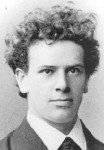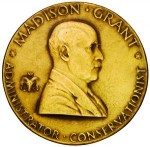In Race and Anthropology – Part 1 I mentioned Franz Boas in passing, giving a preview of where the discusion was going. Here we’ll finally review in detail who Franz Boas was and what he did.
Franz Boas, from Wikipedia:
Franz Boas (/ˈfrɑːnz ˈboʊ.æz/; July 9, 1858 – December 21, 1942)[2] was a German-American anthropologist and a pioneer of modern anthropology who has been called the “Father of American Anthropology”[3][4] and “the Father of Modern Anthropology”.[5] Like many such pioneers, he trained in other disciplines; he received his doctorate in physics, and did post-doctoral work in geography. He applied the scientific method to the study of human cultures and societies; previously this discipline was based on the formulation of grand theories around anecdotal knowledge.
Although his grandparents were observant Jews, his parents embraced Enlightenment values, including their assimilation into modern German society.
Boas vocally opposed anti-Semitism and refused to convert to Christianity, but he did not identify himself as a Jew;[8] indeed, according to his biographer, “He was an ‘ethnic’ German, preserving and promoting German culture and values in America.”
Boas was appointed lecturer in physical anthropology at Columbia University in 1896, and promoted to professor of anthropology in 1899. However, the various anthropologists teaching at Columbia had been assigned to different departments. When Boas left the Museum of Natural History, he negotiated with Columbia University to consolidate the various professors into one department, of which Boas would take charge. Boas’ program at Columbia became the first Ph.D. program in anthropology in America.
In his 1907 essay, “Anthropology”, Boas identified two basic questions for anthropologists: “Why are the tribes and nations of the world different, and how have the present differences developed?”
Boas also presented himself as a role model for the citizen-scientist, who understand that even were the truth pursued as its own end, all knowledge has moral consequences. The Mind of Primitive Man ends with an appeal to humanism:
I hope the discussions outlined in these pages have shown that the data of anthropology teach us a greater tolerance of forms of civilization different from our own, that we should learn to look on foreign races with greater sympathy and with a conviction that, as all races have contributed in the past to cultural progress in one way or another, so they will be capable of advancing the interests of mankind if we are only willing to give them a fair opportunity.
Where Boas was at odds with Madison Grant, eugenics and race science:
His most important research in this field was his study of changes in body form among children of immigrants in New York. Other researchers had already noted differences in height, cranial measurements, and other physical features between Americans and people from different parts of Europe. Many used these differences to argue that there is an innate biological difference between races. Boas’ primary interest—in symbolic and material culture and in language—was the study of processes of change; he therefore set out to determine whether bodily forms are also subject to processes of change. Boas studied 17,821 people, divided into seven ethno-national groups. Boas found that average measures of cranial size of immigrants were significantly different from members of these groups who were born in the United States. Moreover, he discovered that average measures of cranial size of children born within ten years of their mothers’ arrival were significantly different from those of children born more than ten years after their mothers’ arrival. Boas did not deny that physical features such as height or cranial size were inherited; he did, however, argue that the environment has an influence on these features, which is expressed through change over time. This work was central to his influential argument that differences between races were not immutable.
Madison Grant mocked Boas’ result in The Passing of the Great Race, but the case that it was an outright fraud has only been made recently. In 2002 the raw data was reexamined and the results were not as Boas claimed. Wiki mentions the controversy but misrepresents the claims on each side. More on this later.
Boas did not try to claim that race and racial differences do not exist. He argued instead that race is plastic – that the observable differences are not immutable. This is the thin edge of the, “Race may exist, but it isn’t really important.” line of argument.
As the Wiki article notes, this is considered Boas’ “most important research”. This sentiment is echoed elsewhere by those who agree with him.
Wiki relates an anecdote concerning Boas’ strong identification with jews. Boas delivered a speech at a black university in Atlanta in 1906 in which he described several historic situations that had “brought different peoples into an unequal relation”:
the best example, for Boas, of this phenomenon is that of the Jews in Europe:
Even now there lingers in the consciousness of the old, sharper divisions which the ages had not been able to efface, and which is strong enough to find — not only here and there — expression as antipathy to the Jewish type. In France, that let down the barriers more than a hundred years ago, the feeling of antipathy is still strong enough to sustain an anti-Jewish political party.
Boas’ closing advice is that Negroes should not look to Whites for approval or encouragement, because people in power usually take a very long time to learn to sympathize with people out of power.
French nationalists rightly recognize that the jews who happen to live in France consider themselves a separate people who care first and foremost for themselves as jews and jews in general. Just as Boas did. Europeans have long criticized jews for constituting a “nation within a nation.” European nationalists are today routinely pathologized and demonized for doing so.
Contemporary headlines reflect the fact that jews are the people in power today. Hollande vows to wipe out anti-Semitism, 2 Nov 2012:
“France will hunt down terrorism … by all possible means,” Hollande said during an emotional service on Thursday at the Ohr Torah school in Toulouse, where the four were shot dead by Al-Qaeda-inspired killer Mohamed Merah on March 19.
“My country will not be weak in fighting terrorism,” he said.
Pledging to “eradicate” anti-Semitism, Hollande promised all-out measures to ensure the security of Jews.
“Safeguarding their safety, their integrity and their dignity is a national cause…. It is not only the affair of Jews but of all French people.”
“Let us learn the lessons of this ordeal for humanity, for mankind,” he said, adding: “We shall never forget.”
In the US in the early 20th century, Boas sympathized with blacks, specifically as a jew, and collaborated with them against Whites.
One early reaction to the news of Boas’ cephalic index data fraud came from Sam Francis in 2002. Franz Boas – Liberal Icon, Scientific Fraud:
In political terms, if human beings have few or no “fixed characters” and are shaped by the social environment, then what we know as modern liberalism is in business. So is communism, which also assumes that human beings can be transformed by manipulating the social environment.
Francis’ conclusion:
Not only has a giant of modern social science—and a pillar of modern liberalism—tumbled from his pedestal, but the dogma that man is merely a blank slate, on which state bureaucrats and social engineers may scribble whatever ideologies they please, has toppled with him.
If that dogma really can be killed, then much of the tyranny and chaos it has helped create will die with it.
Ten years on I think it’s safe to say this was overly optimistic.
The podcast will be broadcast and available for download on Tuesday at 9PM ET.
Podcast: Play in new window | Download













